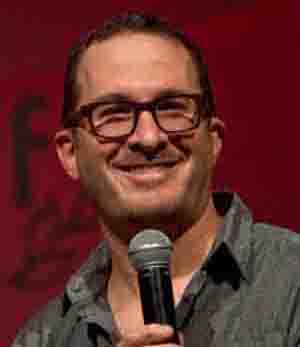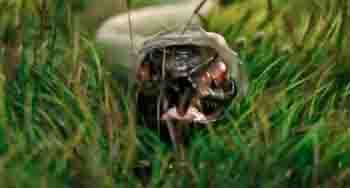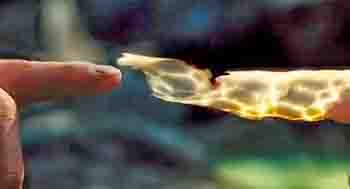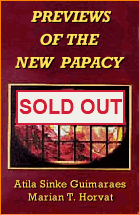Movie Review
 |
 |
 |
 |
 |
 |
 |
Part I
Noah’s Theosophic Underpinnings
To say the least, Darren Aronofsky’s controversial film Noah is disturbing. We left the theater asking: How can a movie with a biblical name be so unbiblical? In fact, Aronofsky himself has admitted that "Noah is the least biblical film ever made."
 So, what was the message of this dark broody $150 million dollar rendition of the Flood, with its flawed hero Noah (Russell Crowe), the meat-eater villain Tubal-Cain (Ray Winstone), the occult shaman Methuselah (Anthony Hopkins) and the grotesque boulder giants, or Fallen Angels, who gave a science fiction tone to the narrative.
So, what was the message of this dark broody $150 million dollar rendition of the Flood, with its flawed hero Noah (Russell Crowe), the meat-eater villain Tubal-Cain (Ray Winstone), the occult shaman Methuselah (Anthony Hopkins) and the grotesque boulder giants, or Fallen Angels, who gave a science fiction tone to the narrative.
But this film is clearly more than just a sci-fi extravaganza.
To prepare for its making, Aronofsky, a cultural Jew whom many reviewers dismiss as an atheist, spent over 15 years studying Jewish Kabbalah accounts and Midrashic retellings of the Flood. What he is really portraying is a Theosophic and Gnostic account of Creation, throwing in a good dose of the Green Revolution to please today’s environmentalists.
In the beginning…
The film opens with a Creation story: Adam and Eve are luminescent, pure light, in the Garden of Eden. But this changes after they are “tempted” by the serpent to eat the apple of knowledge to become like gods. For this transgression, the “creator” punishes them by imprisoning them in flesh and issuing the sentence they must labor and suffer.
This “creator,” presented as a "bad god," is the Triune God whom Catholics adore. Theosophy presnts Him as a "bad god," who did not want man to have knowledge (Gnosis in Greek). In Noah the same "bad god" punished the angels who wanted to bring knowledge to fallen man by imprisoning them in rock and mud. On the contrary, the Serpent is presented as good. In the Serpent is the "good god," unjustly imprisonned by the "bad god."
 This is the upside-down world of Theosophy, the religion behind all the false religions, where the True God is the "bad god" who wanted to prevent man from reaching a godlike state, and the devils are really the "good angels" who want to help mankind make the evolutionary leap that would release men from matter and return them to their original state of light.
This is the upside-down world of Theosophy, the religion behind all the false religions, where the True God is the "bad god" who wanted to prevent man from reaching a godlike state, and the devils are really the "good angels" who want to help mankind make the evolutionary leap that would release men from matter and return them to their original state of light.
In Aronofsky’s Noah, then, we have the two strains of man:
• First, there is the bad carnal and material line of Cain, represented in the film by the wild, sadistic, meat-eating barbarians led by their king Tubal-Cain. These Cainites ravage the earth looking for a mineral called zohar (splendor in Hebrew), love weapons and war, and follow to a tee the "bad" creator’s command to dominate the earth. These are men made in the image of the "bad god" of creation.
Most of mankind – including us, I suppose – are wrongly following this line because we serve the wrong god – the "bad creator." In Noah these bad people must be punished not for immorality, unnatural vices and idolatry, but for violence and their “sins” against the environment. We don’t need to tell you Noah is receiving rant reviews from the progressivist and green movements.
• Second, we have the good but flawed line of Noah who seeks enlightenment. He has that original knowledge but is trapped by his flesh and his commitment to the "bad creator." Poor Noah is slavishly obedient to the "bad" creator’s command to build an ark to save the innocent animals, be their caretakers during and after the Flood and then allow man, doomed by his desire to dominate and kill, to die out. The Flood is to save animals; his mission, to save the Earth and all the beasts and fowl.
 There is, however, a moment of “enlightenment” that Noah experiences. This is when he acts on mercy instead of justice, and realizes that the voice of "good god" comes from within, from a choice of conscience that man can make, regardless of any laws or commands.
There is, however, a moment of “enlightenment” that Noah experiences. This is when he acts on mercy instead of justice, and realizes that the voice of "good god" comes from within, from a choice of conscience that man can make, regardless of any laws or commands.
The little bit of light – of the "good god" – that still resides in man is thus found in Noah and his seed in the cleansed world, and the movie ends as he starts that quest for fulfillment. The evolutionary process of man’s journey to full enlightenment begins, and even though at first only a few “illuminated ones” will follow this path, therein lies the real answer of “salvation” for man until he achieves the original plan of the “good god.”
Yes, everything is mixed up. Theosophy is the religion followed by occult religions, the Kaballah, and Freemasonry. In the end, the God we adore is the "bad god," and the "good god" is the Devil we despise. The good angels are really the "bad angels" who keep us imprisoned in flesh as individuals in a world of darkness and suffering, and the devils – the “Watchers” in the film - are the "good angels" who want to help us return to the original state of pure light. The real “deceiver” is not Satan, but the Triune God whom Catholics adore and serve.
Once you have the basic Theosophic line of Aronosky’s Noah, all the rest is filler and Hollywood effects. The real message is that the Bible has the message all wrong. Our real covenant is not with the "cruel god" of Genesis who sent the Flood, but with the Serpent, which wants to help men to become gods, to return to their original state of light.
The Serpent skin at the beginning and end
After the creation story – according to Theosophy and not Genesis – we find Lamech about to bless his son Noah and pass on the "sacred relic" that supposedly symbolizes his covenant with the “creator.” In the real Genesis, Noah and his forbearers made holocausts – sacrifices – to God as a sign of their obedience and adoration.
 In this film, we find no sacrifice or sign of adoration, but an exchange from father to son of a luminous Serpent skin, a symbol of man’s covenant with the tempter Serpent and the "good god" who wants to bring man to knowledge, gnosis, enlightenment.
In this film, we find no sacrifice or sign of adoration, but an exchange from father to son of a luminous Serpent skin, a symbol of man’s covenant with the tempter Serpent and the "good god" who wants to bring man to knowledge, gnosis, enlightenment.
Lamech is killed by marauders led by Tubal Cain, who steals the Serpent skin, which loses its luminosity in the hands of the “unenlightened.” Tubal Cain exalts because he has wiped out the line of Lamech, but Lamech’s son, the boy Noah, had hidden, and he remains. Needless to say, none of this follows Scriptures or Tradition.
The Serpent skin, the key in this film that unlocks the Theosophic message, makes symbolic appearances in the film, going from Tubal Cain to Noah’s “bad” son Ham, who is tempted to eat meat and carry weapons like the sons of Cain. Finally, when Ham rejects his father, he rejects the skin and what it represents, flinging it back to Noah as he sets off to make his own way – Cain’s way of violence and domination – in the world.
The last scene of the movie shows a Noah reconciled with his conscience wearing the luminous Serpent skin and blessing his family. Then and only then does a rainbow appear, a sign of a covenant not with God, who is ignored, but with the Serpent. We can realize that even in Noah’s flawed line, some will embrace mercy, peace, the ecology, enlightenment, and that man has a second chance to make a great “crucial leap into a new dimension” in the evolutionary process and finally become gods.
Continued


The hero Noah and villain Tubal-Cain represent two lines of men
But this film is clearly more than just a sci-fi extravaganza.
To prepare for its making, Aronofsky, a cultural Jew whom many reviewers dismiss as an atheist, spent over 15 years studying Jewish Kabbalah accounts and Midrashic retellings of the Flood. What he is really portraying is a Theosophic and Gnostic account of Creation, throwing in a good dose of the Green Revolution to please today’s environmentalists.
In the beginning…
The film opens with a Creation story: Adam and Eve are luminescent, pure light, in the Garden of Eden. But this changes after they are “tempted” by the serpent to eat the apple of knowledge to become like gods. For this transgression, the “creator” punishes them by imprisoning them in flesh and issuing the sentence they must labor and suffer.
This “creator,” presented as a "bad god," is the Triune God whom Catholics adore. Theosophy presnts Him as a "bad god," who did not want man to have knowledge (Gnosis in Greek). In Noah the same "bad god" punished the angels who wanted to bring knowledge to fallen man by imprisoning them in rock and mud. On the contrary, the Serpent is presented as good. In the Serpent is the "good god," unjustly imprisonned by the "bad god."

Director Aronofsky presents a Theosophic and Gnostic account of Creation
In Aronofsky’s Noah, then, we have the two strains of man:
• First, there is the bad carnal and material line of Cain, represented in the film by the wild, sadistic, meat-eating barbarians led by their king Tubal-Cain. These Cainites ravage the earth looking for a mineral called zohar (splendor in Hebrew), love weapons and war, and follow to a tee the "bad" creator’s command to dominate the earth. These are men made in the image of the "bad god" of creation.
Most of mankind – including us, I suppose – are wrongly following this line because we serve the wrong god – the "bad creator." In Noah these bad people must be punished not for immorality, unnatural vices and idolatry, but for violence and their “sins” against the environment. We don’t need to tell you Noah is receiving rant reviews from the progressivist and green movements.
• Second, we have the good but flawed line of Noah who seeks enlightenment. He has that original knowledge but is trapped by his flesh and his commitment to the "bad creator." Poor Noah is slavishly obedient to the "bad" creator’s command to build an ark to save the innocent animals, be their caretakers during and after the Flood and then allow man, doomed by his desire to dominate and kill, to die out. The Flood is to save animals; his mission, to save the Earth and all the beasts and fowl.

The Serpent, the "good god" who wants to help man find knowledge and become gods
The little bit of light – of the "good god" – that still resides in man is thus found in Noah and his seed in the cleansed world, and the movie ends as he starts that quest for fulfillment. The evolutionary process of man’s journey to full enlightenment begins, and even though at first only a few “illuminated ones” will follow this path, therein lies the real answer of “salvation” for man until he achieves the original plan of the “good god.”
Yes, everything is mixed up. Theosophy is the religion followed by occult religions, the Kaballah, and Freemasonry. In the end, the God we adore is the "bad god," and the "good god" is the Devil we despise. The good angels are really the "bad angels" who keep us imprisoned in flesh as individuals in a world of darkness and suffering, and the devils – the “Watchers” in the film - are the "good angels" who want to help us return to the original state of pure light. The real “deceiver” is not Satan, but the Triune God whom Catholics adore and serve.
Once you have the basic Theosophic line of Aronosky’s Noah, all the rest is filler and Hollywood effects. The real message is that the Bible has the message all wrong. Our real covenant is not with the "cruel god" of Genesis who sent the Flood, but with the Serpent, which wants to help men to become gods, to return to their original state of light.
The Serpent skin at the beginning and end
After the creation story – according to Theosophy and not Genesis – we find Lamech about to bless his son Noah and pass on the "sacred relic" that supposedly symbolizes his covenant with the “creator.” In the real Genesis, Noah and his forbearers made holocausts – sacrifices – to God as a sign of their obedience and adoration.

The only 'religious' ritual in Noah is with the luminous Serpent skin that passes from father to son
Lamech is killed by marauders led by Tubal Cain, who steals the Serpent skin, which loses its luminosity in the hands of the “unenlightened.” Tubal Cain exalts because he has wiped out the line of Lamech, but Lamech’s son, the boy Noah, had hidden, and he remains. Needless to say, none of this follows Scriptures or Tradition.
The Serpent skin, the key in this film that unlocks the Theosophic message, makes symbolic appearances in the film, going from Tubal Cain to Noah’s “bad” son Ham, who is tempted to eat meat and carry weapons like the sons of Cain. Finally, when Ham rejects his father, he rejects the skin and what it represents, flinging it back to Noah as he sets off to make his own way – Cain’s way of violence and domination – in the world.
The last scene of the movie shows a Noah reconciled with his conscience wearing the luminous Serpent skin and blessing his family. Then and only then does a rainbow appear, a sign of a covenant not with God, who is ignored, but with the Serpent. We can realize that even in Noah’s flawed line, some will embrace mercy, peace, the ecology, enlightenment, and that man has a second chance to make a great “crucial leap into a new dimension” in the evolutionary process and finally become gods.
Continued

Posted May 7, 2014
______________________
______________________











